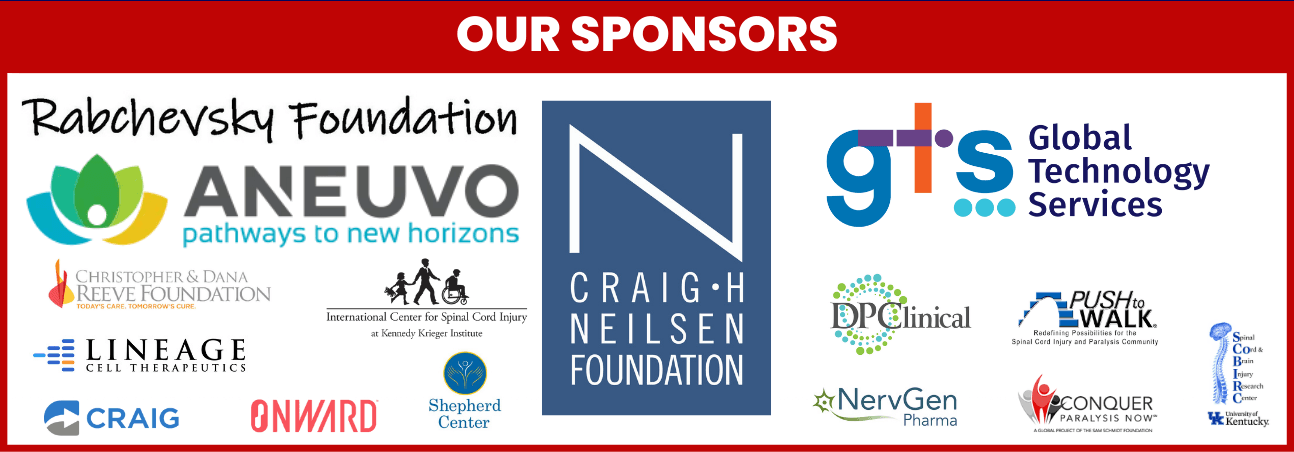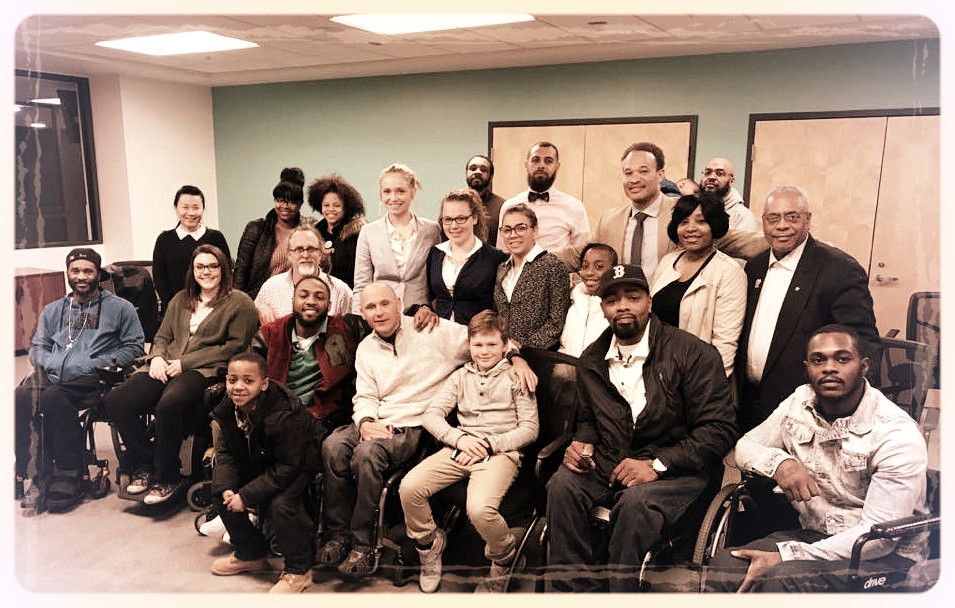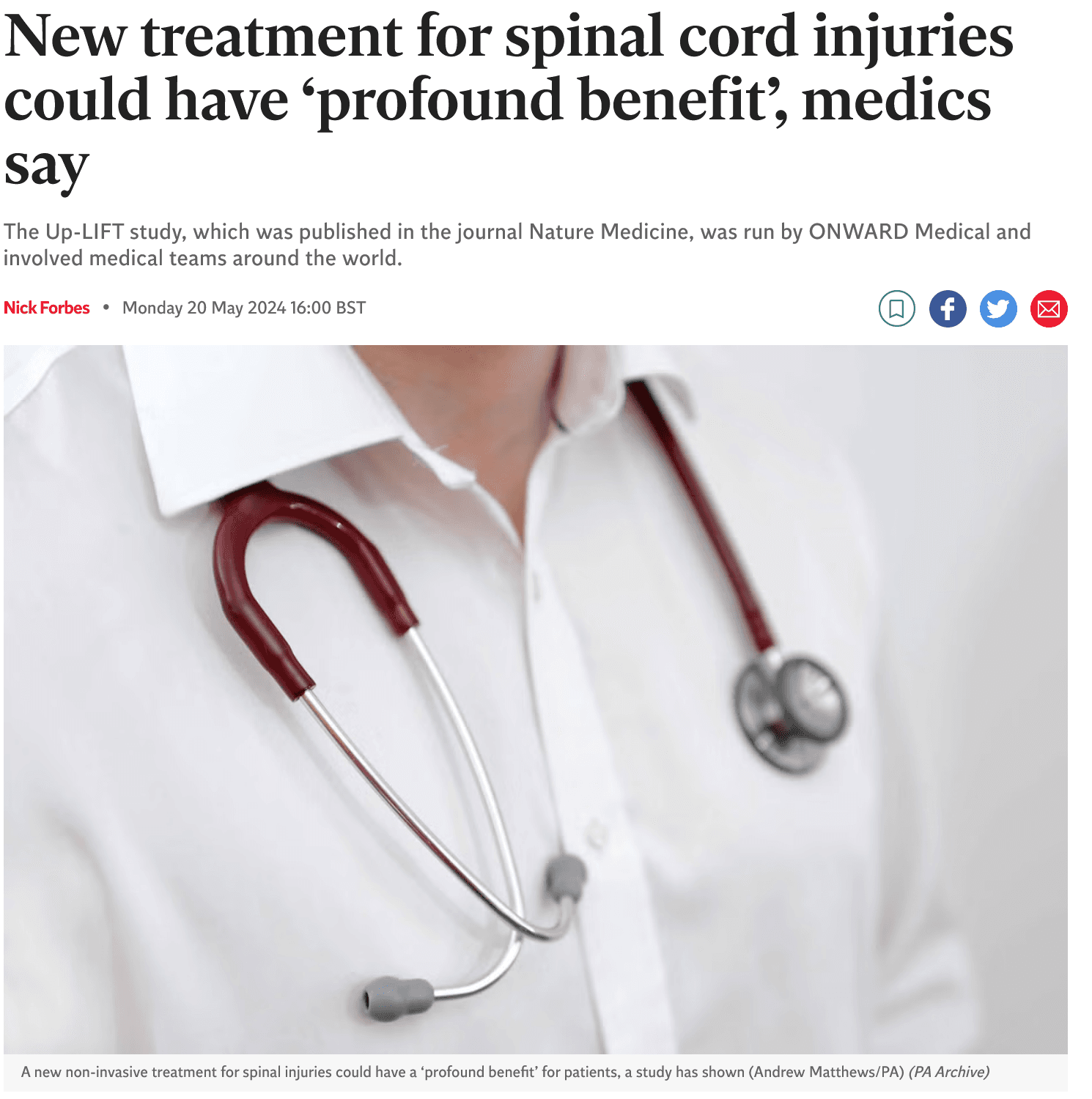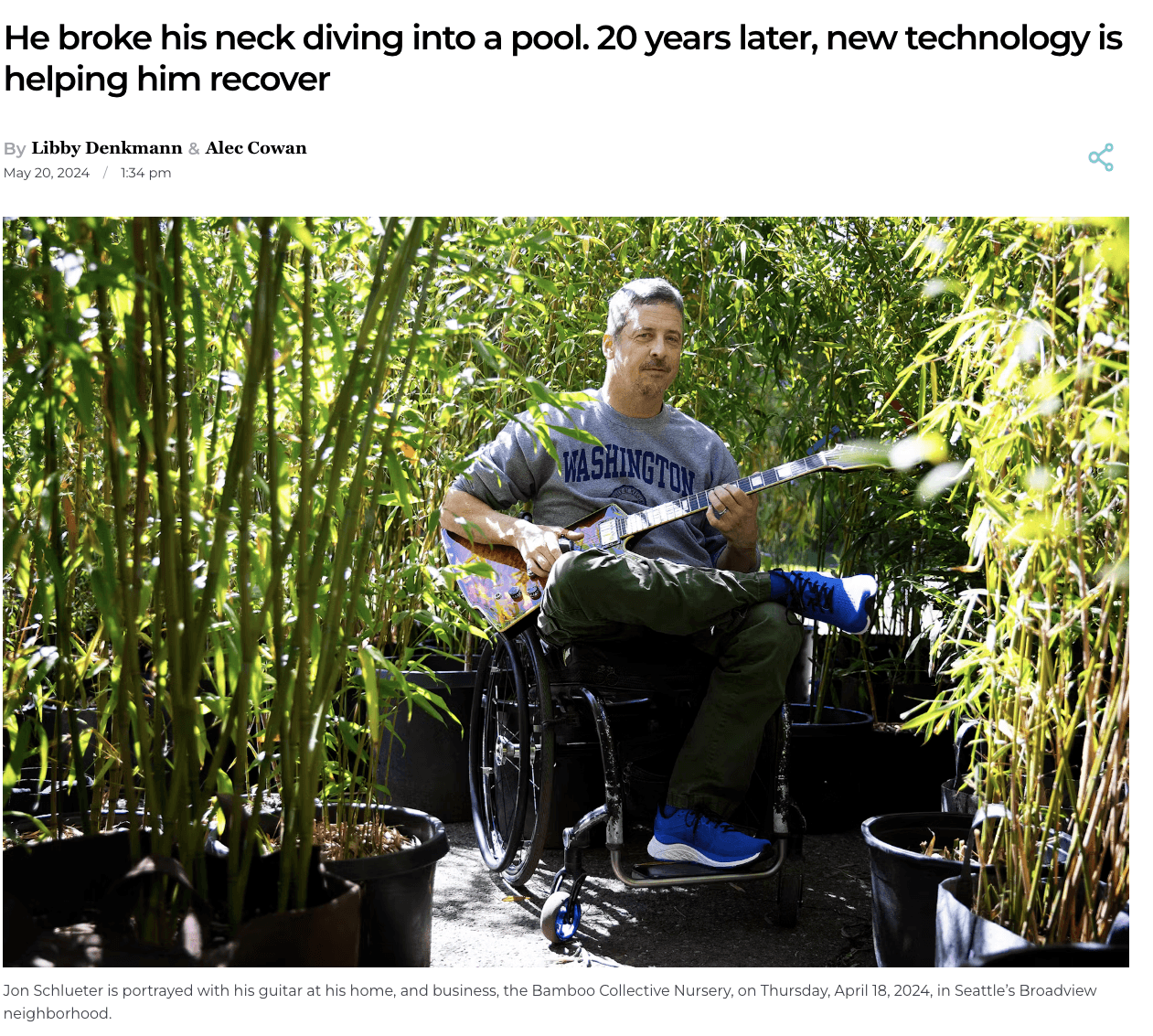June 27, 2024
Headline Patrol: ONWARD’s ARC-EX - Here Comes Stim
Sam Maddox
You probably saw some recent spinal cord injury research news, impressive clinical trial results for hand and arm function in chronic cervical SCI using noninvasive, skin-surface stimulation. I might suggest this headline: Stim has arrived; SCI medicine enters new era.
Spinal cord stimulation has been shown to work – it’s not ‘miraculous’ work, but there is a measurable benefit and users like it. Now, The ARC-EX device is in the queue for FDA and European approval. Participants got what the study was looking for, arm and hand improvement. Some also got improvement in pain, spasticity, sleep, and cognition.
The above headline, from Scotland, reports benefits for 10-year SCI vet Melanie Reid, a journalist who said transcutaneous spinal cord stimulation gave her a “real boost.” “Your hands are so intrinsically taken for granted,” said Reid, “but they are vital to so many aspects of someone’s quality of life. My hands were much more useful and it gave me much more confidence, particularly to use my left hand.”
This article about Jon Schlueter (pictured above) is from the Seattle NPR station KUOW, reported in personalized detail because study Principal Investigator Chet Moritz is local, from the University of Washington. Jon broke his neck diving into a pool 20 years ago and lost most body function below the chest. Schlueter participated in the stim trial. He responded, quite pleasingly, gaining enough hand function to shape chords and play guitar – when the stim device is powered on, and more importantly, when it’s switched off.
Listen to the CureCast
Here is the study, based on the Up-LIFT clinical trial, published a few weeks ago in Nature Medicine: Non-invasive spinal cord electrical stimulation for arm and hand function in chronic tetraplegia: a safety and efficacy trial. I’m not going to slice into it much here. Instead, I urge you to listen to the most recent CureCast, with guest Dave Marver, CEO of ONWARD, the company testing the device and preparing to sell it. He puts things in the perspective of a fledgling device company that has a real shot at a win.
ONWARD, based in the Netherlands, was formed from the bones of Los Angeles start-up NeuroRecovery Technology, which had emerged from the Reggie Edgerton labs at UCLA. It was first called GTX, and was co-founded by the ‘G’ in the name, Gregoire Courtine, Edgerton’s former student and primary author of the new hand-function paper.
Courtine, mentioned often here and on the CureCast, is a major spinal cord stim investigator, better known for his epidural implant studies. In recent years he has extended his expertise to brain-machine interface experiments and to exploring the regenerative potential of the damaged cord.
ONWARD has seen positive results for ARC-EX over many months of testing, and the SCI community has been hearing anecdotally about this for many years – from ONWARD but also from two LA based neuromod startups currently running clinical trials for transcutaneous spinal cord stimulation, Aneuvo and SpineX, the latter formed by Edgerton.
The Up-LIFT paper resets the board. Says Marver, “We can see the finish line.” He won’t predict approval timing for the ARC-EX. Maybe news will break in time for U2FP’s Annual Science and Advocacy Symposium, in Atlanta, September 27-28 (register here). Marver has agreed to speak there.
The skin-surface device works by having electrode leads attached in the neck area above and below the injury site; these provide two kinds of electrical signal, one to numb the skin and one to reach the nerve networks of the spinal cord. The stim is applied during structured rehabilitation. This is from Moritz’s NPR interview:
What we think is happening is the sensory nerves are helping the motor neurons become ready to fire, so that any remaining signal from the brain that can make it through the spinal cord injury is able to have that immediate effect and cause that movement.
The goal is to bring the neurons in the spinal cord closer to threshold so that your brain can turn them on when you want to move.
If two neurons are active at about the same time, and one neuron causes another neuron to become active, the synapses between those neurons become stronger.
We find when we turn the stimulator off, almost all the benefits they gained during stimulation persist — and not just for a day or two, but for up to three months, as long as we've been able to measure.
Participants averaged six years post injury with one being 34 years out. They got two months of functional task training before getting stim over a period of two more months. The study results were all measured with the stimulation off. Indeed the beneficial effects persisted in the absence of stim. It’s not a neuroprosthetic – like FES, which only works with the power on. That means there’s plasticity, or some biological remodeling going on.
The study reported 72 percent of participants recovered both strength and function, and 90 percent recovered either strength or function. No adverse effects reported. Most participants had not reached a treatment plateau at the end of the measured study. Researchers think that could mean the effect could be even better once these devices are in the hands of clinicians.
From the paper:
This absence of plateau suggests that extending the duration of ARC-EX Therapy beyond the arbitrary 2 months pre-specified in the Up-LIFT trial may not only mediate further improvements in strength, functional performance and sensation in people responding to ARC-EX Therapy but may also enable participants who did not respond to ARC-EX Therapy to meet the pre-established responder criteria if provided with sufficient exposure to the therapy.
No participants were defined as complete injuries – only ASIA B, C and D. Why not include completes? Pure pragmatism. It’s harder to show effect. “We designed this study so it would succeed,” Marver said. Once a device is approved, then a physician can apply it to “real life” SCI parameters, choosing to use it off-label.
The stim improved more than hands and arms. Sensation was also improved. From the paper:
Participants also reported a decrease in the frequency and severity of muscle spasms, improved sleep quality and reduced pain. These improvements translated into significant increases in overall well-being ... as well as outcomes assessing level of independence during activities of daily living, such as improved self-care components relying on arm and hand functions.
It’s not clear how fast, far and wide spinal cord stimulation will be adapted in clinics. A lot of things remain unknown: Which patients respond to stim, and in which ways? Can ONWARD pivot from a testing company to scale up to deliver products to meet demand? During his CureCast interview, Marver says that’s a worry for a company of only 100 people.
How will doctors be trained to prescribe the devices? How will patients find a clinic outside of the major SCI centers that knows what it’s doing? How much training and rehab will be needed, and how much of it will insurance pay for? As for when and where you can get it, here's Marver:
We submitted our De Novo application to the FDA in late March. At this point, we expect FDA clearance sometime late this calendar year. The ARC System will first be available in SCI clinics. Later next year, we expect to release a personal device that will be available for use in homes.
There’s plenty to figure out. This is just the start of bioelectric physiatry. But this news is significant for two reasons: new treatment options will be available to improve the lives of many people living with SCI; and a startup company, formed in part by scientists, will have shown a way to market a therapy to a community generally considered too small to invest in.
Stay curious,
PS - As mentioned above, Marver will be presenting at this year’s Science & Advocacy Symposium in Atlanta on September 27-28 (register here). Check out the full agenda on our website, here.
2024 Science & Advocacy Symposium Sponsors






















